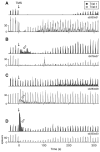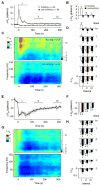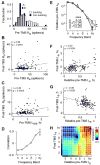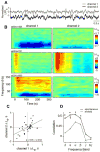State-dependent variability of neuronal responses to transcranial magnetic stimulation of the visual cortex
- PMID: 19409273
- PMCID: PMC2953477
- DOI: 10.1016/j.neuron.2009.03.012
State-dependent variability of neuronal responses to transcranial magnetic stimulation of the visual cortex
Abstract
Electrical brain stimulation is a promising tool for both experimental and clinical applications. However, the effects of stimulation on neuronal activity are highly variable and poorly understood. To investigate the basis of this variability, we performed extracellular recordings in the visual cortex following application of transcranial magnetic stimulation (TMS). Our measurements of spiking and local field potential activity exhibit two types of response patterns which are characterized by the presence or absence of spontaneous discharge following stimulation. This variability can be partially explained by state-dependent effects, in which higher pre-TMS activity predicts larger post-TMS responses. These results reveal the possibility that variability in the neural response to TMS can be exploited to optimize the effects of stimulation. It is conceivable that this feature could be utilized in real time during the treatment of clinical disorders.
Figures








Similar articles
-
Effect of transcranial magnetic stimulation on single-unit activity in the cat primary visual cortex.J Physiol. 2003 Dec 1;553(Pt 2):665-79. doi: 10.1113/jphysiol.2003.050153. Epub 2003 Sep 8. J Physiol. 2003. PMID: 12963791 Free PMC article.
-
Neural responses in cat visual cortex reflect state changes in correlated activity.Eur J Neurosci. 2005 Jul;22(2):465-75. doi: 10.1111/j.1460-9568.2005.04237.x. Eur J Neurosci. 2005. PMID: 16045499
-
Functional organization of envelope-responsive neurons in early visual cortex: organization of carrier tuning properties.J Neurosci. 2012 May 30;32(22):7538-49. doi: 10.1523/JNEUROSCI.4662-11.2012. J Neurosci. 2012. PMID: 22649232 Free PMC article.
-
Neurometabolic coupling in cerebral cortex reflects synaptic more than spiking activity.Nat Neurosci. 2007 Oct;10(10):1308-12. doi: 10.1038/nn1977. Epub 2007 Sep 9. Nat Neurosci. 2007. PMID: 17828254
-
Transcranial magnetic stimulation and vision.Handb Clin Neurol. 2013;116:655-69. doi: 10.1016/B978-0-444-53497-2.00052-8. Handb Clin Neurol. 2013. PMID: 24112931 Review.
Cited by
-
Immediate Effects of Repetitive Magnetic Stimulation on Single Cortical Pyramidal Neurons.PLoS One. 2017 Jan 23;12(1):e0170528. doi: 10.1371/journal.pone.0170528. eCollection 2017. PLoS One. 2017. PMID: 28114421 Free PMC article.
-
Direct current stimulation modulates prefrontal cell activity and behaviour without inducing seizure-like firing.Brain. 2024 Nov 4;147(11):3751-3763. doi: 10.1093/brain/awae273. Brain. 2024. PMID: 39166526 Free PMC article.
-
Thematic Reanalysis in the Left Posterior Parietal Sulcus: A TMS Study.Neurobiol Lang (Camb). 2021 Aug 20;2(3):416-432. doi: 10.1162/nol_a_00043. eCollection 2021. Neurobiol Lang (Camb). 2021. PMID: 37213257 Free PMC article.
-
Enhanced Control of Cortical Pyramidal Neurons With Micromagnetic Stimulation.IEEE Trans Neural Syst Rehabil Eng. 2017 Sep;25(9):1375-1386. doi: 10.1109/TNSRE.2016.2631446. Epub 2016 Nov 22. IEEE Trans Neural Syst Rehabil Eng. 2017. PMID: 27893396 Free PMC article.
-
TMS of posterior parietal cortex disrupts visual tactile multisensory integration.Eur J Neurosci. 2010 May;31(10):1783-90. doi: 10.1111/j.1460-9568.2010.07193.x. Eur J Neurosci. 2010. PMID: 20584182 Free PMC article.
References
-
- Allen EA, Pasley BN, Duong T, Freeman RD. Transcranial magnetic stimulation elicits coupled neural and hemodynamic consequences. Science. 2007;317:1918–1921. - PubMed
-
- Ambrosini A, de Noordhout AM, Sandor PS, Schoenen J. Electrophysiological studies in migraine: a comprehensive review of their interest and limitations. Cephalalgia. 2003;23 1:13–31. - PubMed
-
- Barker AT, Jalinous R, Freeston IL. Non-invasive magnetic stimulation of human motor cortex. Lancet. 1985;1:1106–1107. - PubMed
-
- Berardelli A, Inghilleri M, Rothwell JC, Romeo S, Curra A, Gilio F, Modugno N, Manfredi M. Facilitation of muscle evoked responses after repetitive cortical stimulation in man. Exp Brain Res. 1998;122:79–84. - PubMed
Publication types
MeSH terms
Grants and funding
LinkOut - more resources
Full Text Sources
Other Literature Sources

